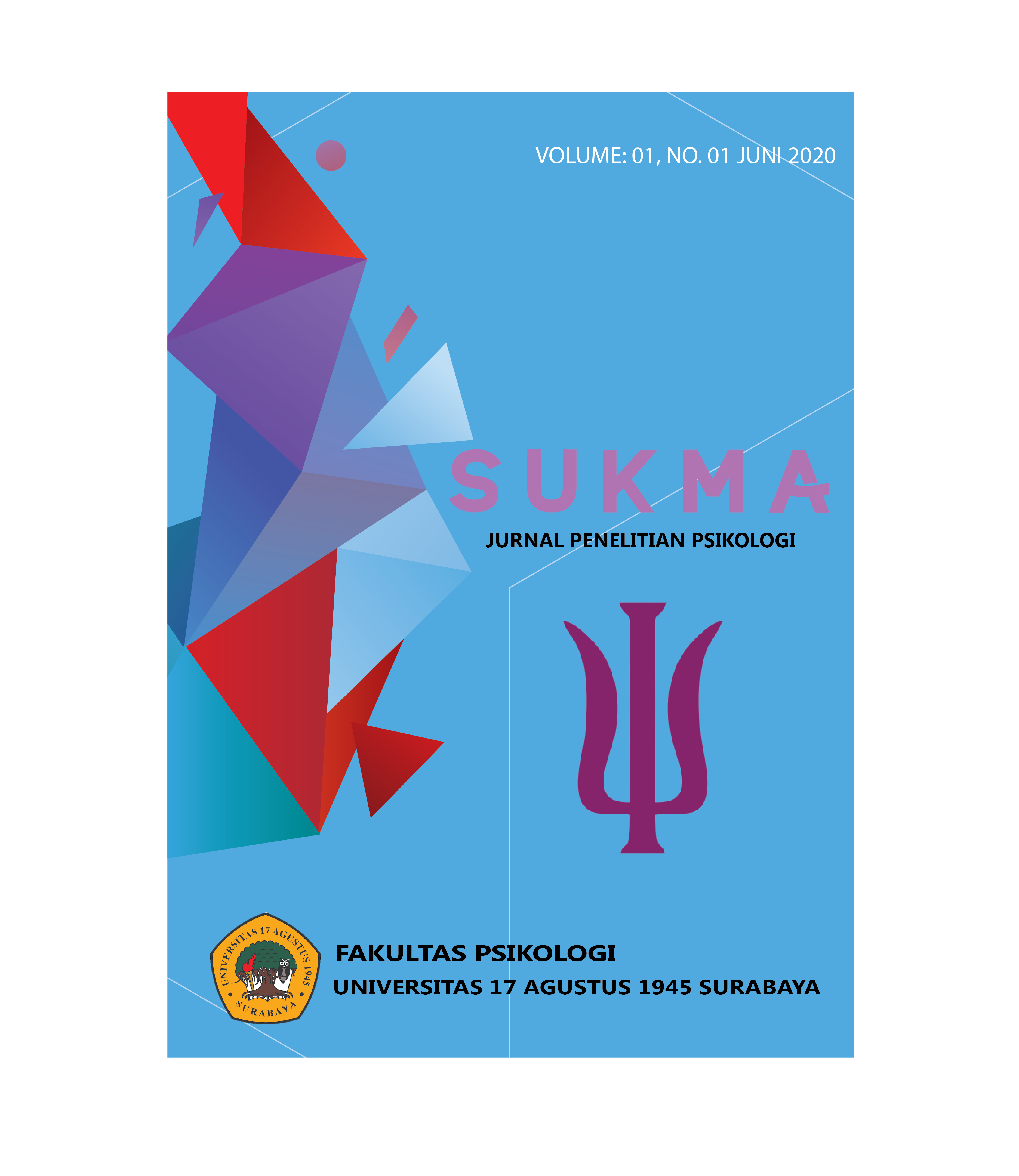Subjective Well-Being dan Kecenderungan Narsisme Pada Individu Dewasa
Abstract
This research aims to know the relationship between subjective well-being with the tendency of narcissism in adulthood. The hypothesis proposed in this study was that there was a negative link between subjective well-being with a tendency to narcissism. It means that the higher subjective well-being one then the lower the tendency of Narcissism. The population in this research is an adult who has a social media account. While the sample in this study amounted to 94 adult respondents aged between 20-40 years. The sampling technique is carried out in a purposive sample. The method of collecting data in this study used a tendency scale of narcissism and a subjective well-being scale. The method of analysis used is the correlation technique of Spearman rho. Data analysis results show the magnitude of the correlation coefficient between the subjective well-being variable with the tendency variable narcissism of -0.283 and P = 0.006 (P ? 0.05). The results showed a significant and negative relationship between subjective well-being with the tendency of narcissism in adults with a percentage of 6,7% in subjective well-being while the remaining of 93,3% was influenced by variables other.
Penelitian ini bertujuan untuk mengetahui hubungan antara subjective well-being dengan kecenderungan narsisme pada individu dewasa. Hipotesis yang diajukan dalam penelitian ini adalah ada hubungan negatif antara subjective well-being dengan kecenderungan narsisme. Artinya semakin tingginsubjective well-being seseorang maka akan semakin rendah kecenderungannnarsismenya. Populasi dalam penelitian ini adalah individu dewasa yang memiliki akun media sosial. Sedangkan sample dalam penelitian ini berjumlah 94 responden individu dewasa berusia antara 20-40 tahun. Teknik pengambilan sample dilakukan dengan cara purposive sampling. Metode pengumpulan data dalam penelitian ini menggunakan skala kecenderungan narsisme dan skala subjective well-being. Metode analisis yang digunakan ialahnteknik korelasi spearman rho. Hasil analisa data menunjukkan besarnya koefisien korelasi antara variabel subjective well-being dengan variabel kecenderungan narsisme sebesar -0,283 dan p= 0,006 (p?0,05). Hasil tersebut menunjukkan adanya hubungan yang negatif dannsignifikan antara subjective well-being dengan kecenderungan narsisme pada individu dewasa dengan prosentase sebesar 6,7% pada subjective well-being sedangkan sisanya sebesar 93,3% dipengaruhi oleh variabel lain. Kata kunci: subjective well-being, kecenderungan narsisme
Downloads
References
Agus, Hermawan. 2012. Komunikasi Pemasaran. Jakarta: Erlangga.
A. Zeithaml, V. Parasuraman, A. and L. Berry L. 1985. “Problems and Strategies in Services Marketing”. Jurnal of Marketing Vol. 49. (Spring).
Alfin R., T. Alhabsji, U. Nimran, dan Suharyono 2013. The effect of Service Quality & Product Quality to Corporate Image, Customer Satisfaction and Customers Jurnal Administrasi Bisnis (JAB)|Vol. 62 No. 1 September
Bachtiar. (2011). Analisa Faktor-Faktor yang Mempengaruhi Kepuasan Mahasiswa dalam Memilih Politeknik Sawunggalih Aji Purworejo. Dinamika Sosial Ekonomi Vol 7 No.1
Dimyati, Mohamad. (2015). The role of customer satisfaction in mediating marketing communication effect on customer loyalty. International Refereed Research Journal www.researchersworld.com Vol.–VI, Issue 4(1), Oct. 2015 [75].
Gregory, J. R., Wiechmann, J. G. Marketing Corporate Image: The Company as Your Number One Product. McGraw-Hill, New York, 2001.
Ghaisani Afidanti, Meidhita. (2018). Pengaruh marketing communi-cation, kualitas produk, dan brand image terhadap keputusan pembelian surat kabar harian suara merdeka (Studi pada PT. Suara Merdeka Press Semarang). Diponegoro Journal of Social and Politic Tahun 2018, Hal. 1-5 http://ejournal-s1.undip.ac.id/index. php/.
Harahap, D. A., & Amanah, D. 2018. Pengantar Manajemen. Bandung: Alfabeta.
Hasan, Ali. (2017). Power relationship marketing dalam bisnis. Jurnal Media Wisata, Volume 15, Nomor 1, Mei 2017
Listyawati, I.H., 2013. Implementasi Relationship Marketing Sebagai Strategi Mempertahankan Loyalitas Pelanggan. JBMA. Vol. 1. No.2. hal. 25-32.
JMM17 Jurnal Ilmu Ekonomi dan Manajemen
September 2019, Vol. 06 No. 02, hal. 1-14
ISSN; 2355-7435
Nindiatma Putri, Deszlaria. (2018). Pengaruh corporate image dan relationship marketing terhadap trust serta dampaknya pada loyalty (Survei pada Seller Anggota Top Community Tokopedia).
Normasari, Selvy. (2013). Pengaruh kualitas pelayanan terhadap kepuasan pelanggan, citra perusahaan dan loyalitas pelanggan (Survei padaTamu Pelanggan yang Menginap di Hotel Pelangi Malang). JurnalAdministrasi Bisnis (JAB) Vol. 6 No. 2 Desember 2013.
Ndubisi, Nelson. Oly. (2003). Cultural Dimension and Relationship Marketing: an African Marketing Model. Journal of Cultural Study, Vol. 5(2), Pg. 214-241.
Putri Pratiwi, Ustantia. (2014). Pengaruh relationship marketing terhadap kepuasan dan loyalitas nasabah (Studi pada Nasabah Bank Jatim Cabang Pasuruan). Jurnal Administrasi Bisnis (JAB)|Vol. 15 No. 2 Oktober 2014 administrasi bisnis.studentjournal.ub.ac.id
Revani, Mousa., et al. 2011. “The Effect Of Relationship Marketing Dimensions by Customer Satisfac-tion To Customer Loyalty”.
Sumarwan, Ujang. 2004. Perilaku Konsumen: Teori dan Penerapan-nya dalam Pemasaran. Bogor: PT.Ghalia Indonesia.
Sidharta, Iwan. (2015). Pengaruh kepuasan transaksi online shopping dan kepercayaan konsumen terhadap sikap serta perilaku konsumen pada E-Commerce
Semuel, Hatane. (2007). Perilaku dan keputusan pembelian konsumen restoran melalui stimulus 50% discount di Surabaya. Jurnal Manajamen Pemasaran, Vol.2, No. 2, Oktober 2007: 73-80
Saparwadi (2016). The effect of relationship marketing on the loyalty of supplier of tobacco with manual drying in PT. Export Leaf Indonesia.
Semuel, H. 2012. Customer Relationship Marketing Pengaruhnya Terhadap Kepercayaan Dan Loyalitas Perbankan Nasional. Jurnal Manajemen Pemasaran. Vol. 7 No. 1. hal. 33-41.









